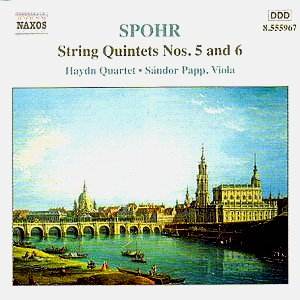Louis
Spohr’s career as a composer encompassed Beethoven’s Opus 18 string
quartets and Wagner’s ‘Tristan and Isolde’. He spent a large part
of his working life as the Kapelmeister in Kassel and was an important
influence in early German Romanticism, writing 9 symphonies, 15
violin concertos and a number of operas including ‘Jessonda’ (perhaps
his best known) and ‘Faust’. As a conductor he was one of the
first people to make use of a baton, a fact which alarmed London
orchestras when he first conducted them. A virtuoso violinist,
Spohr wrote chamber music all his life. The two recorded here
were originally part of a Marco Polo series of Spohr’s quintets
and quartets.
String
Quartet No. 5 was written in August and September 1838 which was
a truly eventful period in the composer’s life. He had lost his
adored first wife, Dorette, in 1834. She had shared his early
successes and the two of them had been a notable harp and violin
duo (Spohr wrote a number of duos for them to play and these have
also been released on Naxos). He married again in 1836 and his
new wife, Mariette, was an accomplished pianist. Encouraged by
her, he wrote a number of chamber pieces with piano parts so that
this string quintet is the only work for strings alone that Spohr
wrote in the first 9 years of his new marriage (previously he
had regularly produced sets of chamber music for strings). June
1838 also saw the tragic death at the age of 19 of Spohr’s youngest
daughter, Therese, who was reputed to be an exact likeness of
her late mother. It was during the recuperation from this event
that Spohr and Mariette met Schumann for the first time. Spohr
and Schumann possessed a not uncritical admiration for each other.
It
was from these momentous events the Quintet no. 5 in G minor arose.
The work has a spaciousness of design and richness of texture
which is lacking in the two previous, more intimate quintets.
The long first movement starts with a powerful unison figure answered
by quiet descending phrases. This opening figure appears in many
guises during the movement. Though there are lighter moments,
the movement is predominantly dark and sombre with a powerfully
anguished outburst in the development. The Haydn Quartet attacks
this movement with soberness and seriousness which entirely suits
the music. The two viola players contribute a welcome depth and
richness to the sound. The following Larghetto, in the warm key
of E flat, is more peaceful. But the rich harmonies are still
occasionally disturbed but darker undercurrents in the cello.
The vigorous Scherzo returns to the home key of G minor, but this
is a restless movement with frequent changes of key and time signature.
Interestingly the Scherzo and the Trio are repeated, but in the
coda the first violin and cello play harmonics which anticipate
one of the key features of Finale. This is a pastoral movement,
with a bagpipe like melody given extra spice by the harmonics.
There is no development section and this light, carefree movement
ends quietly, as if the stresses and strains of the earlier movements
have been resolved.
The
Quintet No. 6 in E minor was composed in February and March 1845.
This was one of a number of concertos and chamber pieces that
he wrote following his last opera ‘Die Kreuzfahrer’. The only
significant chamber works to appear after Quintet No. 5 were piano
trios in which Spohr made a considerable impact with his innovative
writing for the medium. The opening Allegro displays a melancholy
lyricism which is typical of earlier Spohr quartets. The movement
is rich in texture but the melodic interest is less flowing than
some of Spohr’s earlier works. But this is a problem that I find
with these works generally. They are beautifully and effectively
written for the medium, but lack the melodic interest and spark
that is true of Mozart’s works in the genre. The second movement
is a lively Scherzo in A minor, a movement that displays a certain
grim humour which is set off by the gracious Trio. The long, reflective
theme of the Adagio in C is typical of the composer but some contrast
is provided by more pointed rhythms. The finale is a fast and
furious piece that returns to the home key and the agitated mood
carries right through to the end.
The
pieces receive fine performances from the Haydn Quartet with Sandor
Papp on 2nd viola. The Quartet bring a warm tone to
the rich textures of these pieces. The quartet attack the pieces
with a sober earnestness relieved by occasional lightness. For
those collecting the Naxos Spohr chamber music series, I can have
no hesitation at recommending them. For those new to Spohr, this
CD provides a welcome opportunity to hear a less frequently heard
voice of German Romanticism.
Robert
Hugill

